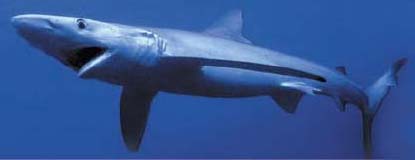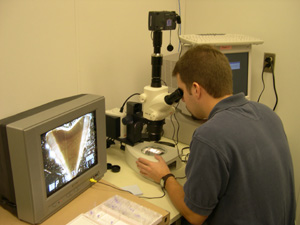
The Florida Program for Shark Research, directed by the Florida Museum of Natural History’s George H. Burgess, is one of four such shark research programs comprising the National Shark Research Consortium. Other member institutions are Moss Landing Marine Laboratory (California), Mote Marine Laboratories (Florida) and the Virginia Institute of Marine Science. The overall objectives of this consortium are to increase scientific knowledge of shark biology as well as to develop public outreach and conservation initiatives.
Among the numerous projects ongoing within the Florida Program for Shark Research is the Commercial Shark Fishery Observer Program. Now entering its 12th year of funding by the U.S. Department of Commerce and the National Marine Fisheries Service, this program places fishery biologists on commercial shark fishing vessels operating in coastal waters of the U.S. east coast from New Jersey to Louisiana. Observers aboard commercial shark fishing vessels collect data on the species composition and fate of the catch and gather information on the biology of the sharks taken in the fishery. These data provide important life history and fishery information for resource managers and are particularly useful in assessing shark populations and regulating shark fishing.

Photo by Florida Program for Shark Research
Alexia Morgan, coordinator of the Commercial Shark Fishery Observer Program, is currently using shark fishery data in her graduate research. According to Morgan, “Accurate fisheries-dependent data on sharks is lacking. Our program provides a robust data set for over 30 species of sharks found in the northwestern Atlantic Ocean and Gulf of Mexico. Poor data sets have always been problematic in population assessments, making our data set invaluable to fisheries managers.”

Photo by Florida Program for Shark Research
“Shark populations have declined worldwide in recent years because of overfishing and because most sharks are slow to reach sexual maturity, they are especially vulnerable” said Burgess, who started the observer program in 1994.
Observers also collect biological samples, including reproductive organs and vertebrae, which researchers then prepare and analyze in the laboratory for several life history projects. At present, scientists know little about the life history, growth, reproduction and maturity of many species of sharks. Researchers at the Florida Program for Shark Research are studying numerous aspects of reproduction in sharks including the reproductive cycle, maturity size and litter size as well as investigating the age and growth of several highly migratory shark species using traditional analysis of vertebral growth rings. Continued research in these areas will fill gaps in our knowledge of shark biology.

Photo by Florida Program for Shark Research
Current species studied by the program include the tiger shark, Galeocerdo cuvier, scalloped hammerhead, Sphyrna lewin, great hammerhead, S. mokarran, sandbar shark, Carcharhinus plumbeus, and blacknose shark, C. acronotus.
The Commercial Shark Fishery Observer Program is but one of the many research and education initiatives undertaken by the Florida Program for Shark Research. The International Shark Attack File, a summary of investigations of all known shark attacks on humans throughout the world, is maintained at the Florida Museum in cooperation with the American Elasmobranch Society, the international organization of researchers studying sharks and their relatives. The Florida Program for Shark Research’s homepage on the Florida Museum of Natural History web site is the largest and most frequently accessed elasmobranch site on the web, providing educational materials on sharks and their relatives as well as serving as a host site for the American Elasmobranch Society, World Conservation Union Shark Specialist Group, the International Shark Attack File, the Commercial Shark Fishery Observer Program and the National Shark Research Consortium.
Cathy Bester is a marine biologist who coordinates the Florida Museum of Natural History Ichthyology Division’s web site and the Florida Program for Shark Research’s education initiatives. She has worked for the Florida Museum for three years.